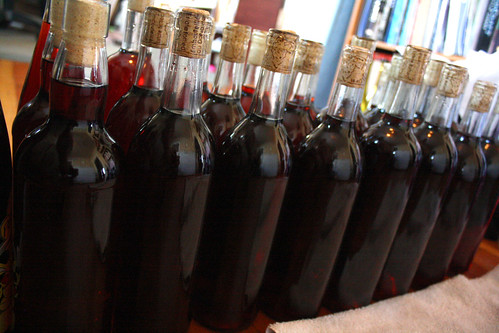Bottling is the final step in the wine making process that requires any effort on your part. After this time takes care of the rest.
The major considerations when bottling are what kind of bottle to use, type of closure, and to add gas or not
Bottles
The type of bottle you use is completely up to you. A bottle’s shape does not impact the taste or life of your wine in any way.
Typically red wines are bottled in dark green bottles to prevent UV exposure which can accelerate the aging process. If you keep your red wines in a dark “cellar” like environment light will not be an issue and you can use whatever color strikes you as awesome.
White wines are typically contained in clear bottles as they are not aged nearly as long as red wines are for the most part. More on this in the bottle aging step.
Closures
A closure is a fancy term for whatever you use to seal your bottles. Most wineries us a cork, synthetic cork, or screw cap. There has been a raging debate arguing the ups and downs of each type of closure. We’ll briefly touch on them here.
Natural Cork
Being both natural and the historical closure of choice natural cork is a good choice. A benefit to natural cork is its ability to let in tiny amounts of oxygen. The small amount of oxygen allows for “micro-oxygenation”, an essential part of long-term bottle aging.
Natural corks have a few drawbacks worth mentioning however. Poorly made corks can deteriorate and leave your wine “corked” (tasting like moldy cork). Even the highest quality cork producers wind up making a few duds. Once a wine is corked there’s nothing you can do about it.
Another draw back is corks that leak. Some corks have a little channel that on the side of the cork that allows wine to leak out. You can’t always see these defects in a cork prior to bottling so it’s a risk you must take to use cork.
Synthetic Cork
Today’s synthetic corks are getting much more sophisticated than the old petroleum-based ones you used to see in the 90’s. Synthetic corks don’t deteriorate, nor do they have a tendency to leak.
Many synthetic corks do not allow for micro-oxygenation. They seal very well. This is fine for a wine you intend to consume within three years or so. Any longer and you’ll want natural cork.
Some synthetic corks are designed to allow for micro-oxygenation but they haven’t been in use long enough to say for sure how they compare to natural cork.
Screw Caps
The latest closure on the scene is the screw cap. Largely thought to be a sign of cheap wine these closures are starting to take hold even in more expensive wineries.
Proponents of screw caps cite the lack of spoiled wine due to bad corks among their chief benefits. Screw caps also aren’t likely to let loose if checked in airline baggage as a cork can.
On the other hand screw caps don’t allow for micro-oxygenation as a natural cork will. Wine drinkers with a sensitive palate have been able to detect petroleum flavors in wines with this type of closure. As the inside of the cap is coated with a plastic to help seal it the wine may in fact pick up undesirable flavors.
In short natural corks are tried and true even if they result in a few bad bottles once in a while. For long-term bottle aging they’re really the most proven closure you can use.
For short-term bottle aging synthetic corks and screw caps are just fine. In fact, all wineries in New Zealand are required to use screw caps. Give one a try to see what you think of the quality.
Adding Inert Gasses
Commercial wineries add an inert gas to the little space left at the top of the bottle after its been filled. This displaces the oxygen prior to closing the bottle so that the wine is not over oxidized.
There are kits for hobbyist wine makers that are quite affordable if you want to give this a try. This expense is really only justifiable if you plan on storing your wine for many years. Let the cork regulate the oxygen for you.
Click here to go back to the wine making process.
Photo by: Andrea Parish – Geyer


Great article..Tightening the bottles is very essential to keep safely the inside liquid. It’s god to have plastic inside the caps. It keeps them safe and are rust resistant that is it can keep the liquor safely without any reaction.
Thanks for the tips I always like to understand why I’m doing these things and how they affect the wine.
You’re very welcome. I believe the more informed we are about each and every step of the wine making process the better the decisions we can make and thus the better wine.
Cheers!
Thanks so much for this! I just bottled my first 6 gallons of wine through a wine kit, and its very good. Have been learning a lot and I have a lot of muscadine grape vines as well as concord, and I made 2 gallons of the muscadine wine and its in the second fermentation, and I also have 1 gallon of cranberry wine fermenting. I love your website and i will be reading it a lot. Thank you so much!
Hello Ann!
I’m so glad that your first fermentations are going so well! Making wine from kits, grapes, and fruit all at once is quite impressive.
Thank you for your kind words regarding the site, I’m glad that you have found it useful. If there’s anything I can do to help you just let me know.
Cheers!
Matt
Not sure about your comment about wineries in New Zealand being required to use a screw cap. We do bottle using cork as well, just not very often!